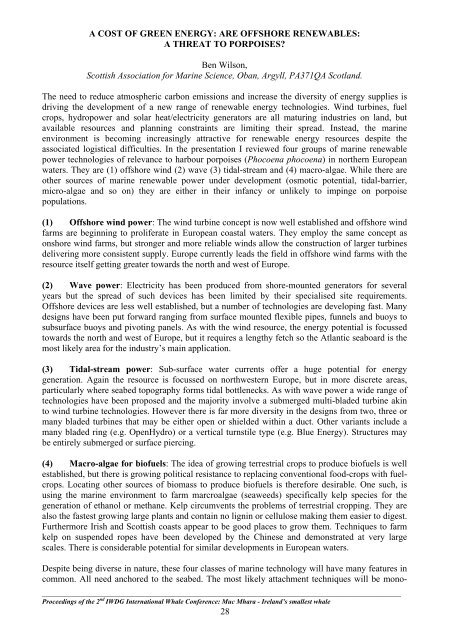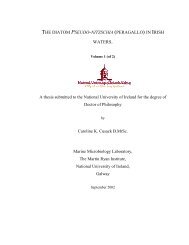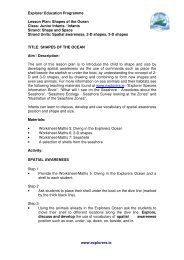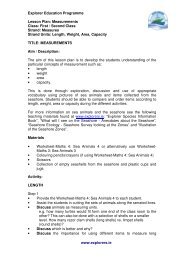Muc Mhara Ireland's Smallest Whale - Marine Institute Open Access ...
Muc Mhara Ireland's Smallest Whale - Marine Institute Open Access ...
Muc Mhara Ireland's Smallest Whale - Marine Institute Open Access ...
You also want an ePaper? Increase the reach of your titles
YUMPU automatically turns print PDFs into web optimized ePapers that Google loves.
A COST OF GREEN ENERGY: ARE OFFSHORE RENEWABLES:<br />
A THREAT TO PORPOISES?<br />
Ben Wilson,<br />
Scottish Association for <strong>Marine</strong> Science, Oban, Argyll, PA371QA Scotland.<br />
The need to reduce atmospheric carbon emissions and increase the diversity of energy supplies is<br />
driving the development of a new range of renewable energy technologies. Wind turbines, fuel<br />
crops, hydropower and solar heat/electricity generators are all maturing industries on land, but<br />
available resources and planning constraints are limiting their spread. Instead, the marine<br />
environment is becoming increasingly attractive for renewable energy resources despite the<br />
associated logistical difficulties. In the presentation I reviewed four groups of marine renewable<br />
power technologies of relevance to harbour porpoises (Phocoena phocoena) in northern European<br />
waters. They are (1) offshore wind (2) wave (3) tidal-stream and (4) macro-algae. While there are<br />
other sources of marine renewable power under development (osmotic potential, tidal-barrier,<br />
micro-algae and so on) they are either in their infancy or unlikely to impinge on porpoise<br />
populations.<br />
(1) Offshore wind power: The wind turbine concept is now well established and offshore wind<br />
farms are beginning to proliferate in European coastal waters. They employ the same concept as<br />
onshore wind farms, but stronger and more reliable winds allow the construction of larger turbines<br />
delivering more consistent supply. Europe currently leads the field in offshore wind farms with the<br />
resource itself getting greater towards the north and west of Europe.<br />
(2) Wave power: Electricity has been produced from shore-mounted generators for several<br />
years but the spread of such devices has been limited by their specialised site requirements.<br />
Offshore devices are less well established, but a number of technologies are developing fast. Many<br />
designs have been put forward ranging from surface mounted flexible pipes, funnels and buoys to<br />
subsurface buoys and pivoting panels. As with the wind resource, the energy potential is focussed<br />
towards the north and west of Europe, but it requires a lengthy fetch so the Atlantic seaboard is the<br />
most likely area for the industry’s main application.<br />
(3) Tidal-stream power: Sub-surface water currents offer a huge potential for energy<br />
generation. Again the resource is focussed on northwestern Europe, but in more discrete areas,<br />
particularly where seabed topography forms tidal bottlenecks. As with wave power a wide range of<br />
technologies have been proposed and the majority involve a submerged multi-bladed turbine akin<br />
to wind turbine technologies. However there is far more diversity in the designs from two, three or<br />
many bladed turbines that may be either open or shielded within a duct. Other variants include a<br />
many bladed ring (e.g. <strong>Open</strong>Hydro) or a vertical turnstile type (e.g. Blue Energy). Structures may<br />
be entirely submerged or surface piercing.<br />
(4) Macro-algae for biofuels: The idea of growing terrestrial crops to produce biofuels is well<br />
established, but there is growing political resistance to replacing conventional food-crops with fuelcrops.<br />
Locating other sources of biomass to produce biofuels is therefore desirable. One such, is<br />
using the marine environment to farm marcroalgae (seaweeds) specifically kelp species for the<br />
generation of ethanol or methane. Kelp circumvents the problems of terrestrial cropping. They are<br />
also the fastest growing large plants and contain no lignin or cellulose making them easier to digest.<br />
Furthermore Irish and Scottish coasts appear to be good places to grow them. Techniques to farm<br />
kelp on suspended ropes have been developed by the Chinese and demonstrated at very large<br />
scales. There is considerable potential for similar developments in European waters.<br />
Despite being diverse in nature, these four classes of marine technology will have many features in<br />
common. All need anchored to the seabed. The most likely attachment techniques will be mono-<br />
_________________________________________________________________________________________________________<br />
Proceedings of the 2 nd IWDG International <strong>Whale</strong> Conference: <strong>Muc</strong> <strong>Mhara</strong> - Ireland’s smallest whale<br />
28





